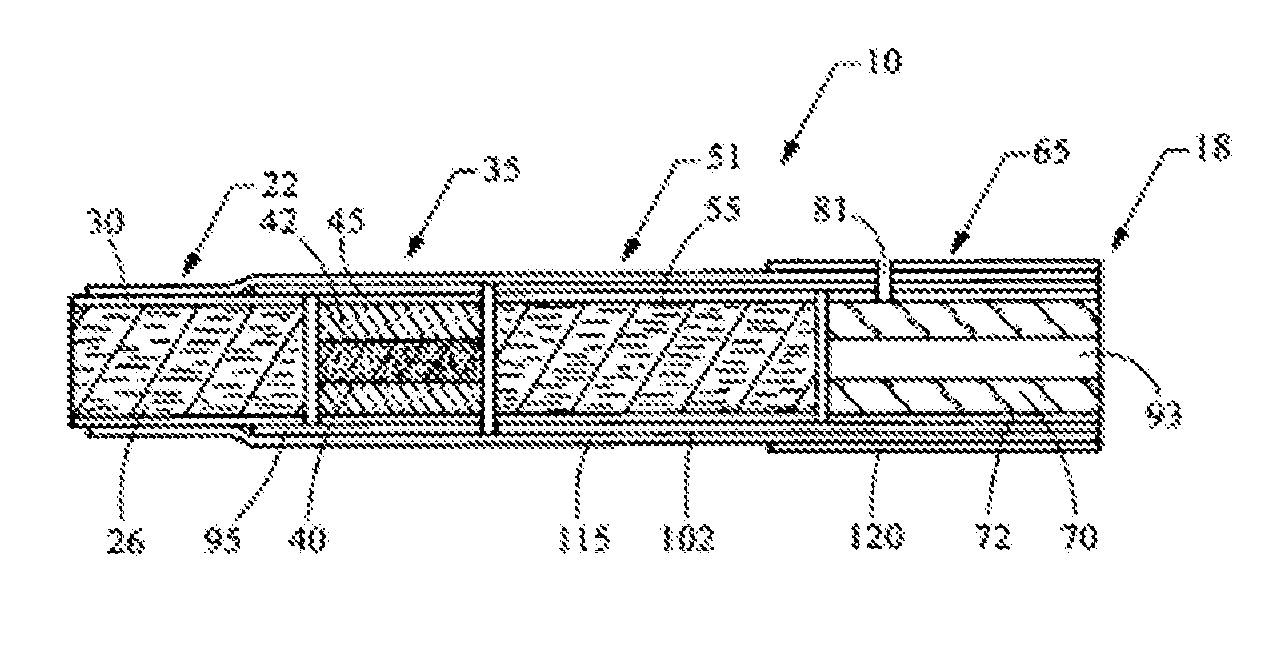Smoking article
a technology for smoking articles and tobacco substitute materials, applied in the field of tobacco products, can solve the problems that smoking articles that employ heat sources, flavored vapors or tobacco-flavored visible aerosols have not received widespread commercial success, and achieve the effect of reducing the amount of carbon monoxide present and reducing the amount of carbon monoxid
- Summary
- Abstract
- Description
- Claims
- Application Information
AI Technical Summary
Benefits of technology
Problems solved by technology
Method used
Image
Examples
example 1
Catalytic or Oxidative Conversion of Carbon Monoxide to Carbon Dioxide Using Cerium Oxide Fine and Ultrafine Particles on Titania Support
[0172]Titania (TiO2) pellets obtained from Alfa Aesar, Ward Hill, Mass., are ground in a mortar-pestle and sieved. The −16+30 (US mesh) fraction is collected. The granules are washed and dried overnight in an oven set at 130° C.
[0173]Approximately 35 g of the dried TiO2 granules are impregnated with about 5 ml of cerium oxide suspension obtained from Alfa Aesar. The average diameter of those ceria particles in the suspension is about 20 nm. The TiO2 granules impregnated with the cerium oxide fine and ultrafine particles are dried overnight at 130° C. After drying, the TiO2 particles are treated with a second 5 ml suspension of cerium oxide. The granules are dried overnight at 130° C., and subsequently heated in a furnace at 400° C. for 16 hours. The final yield of the titania impregnated with cerium oxide catalyst is 33 grams. All washings are admi...
example 2
Smoking Articles Comprising Fuel Elements in Intimate Contact with Coarse, Fine or Ultrafine Particles of Metal Oxide
[0175]Several fuel elements from smoking articles marketed by R.J. Reynolds Tobacco Company under the brand name “Eclipse” are obtained. Each fuel element is dip-coated in only one of the seven solutions (A-G) set forth in Table I. Solutions A-F comprise coarse, fine or ultrafine particles of metal oxides; while solution G is a control and only contains water.
[0176]
TABLE IDip Coating Solutions for Fuel Elements (Amount in grams)20% SolSolu-CeO2,tionWaterpH 3.0Al2O3TiO2Cu(NO3)2Fe2O3A04.800.23000B6.3000.35000C4.58000.3900D06.1400.3100E05.00000.440F1.38000.0500.04G10.0000000
[0177]Preparation and dilutions of suspensions of cerium oxide are made with Nanopure water. Aqueous suspensions of cerium oxide (in acetate, pH 3.0, average particle size 10-20 nm) are obtained from Alfa Aesar. Titania and alumina nanopowders are obtained from Nanopowder Enterprises Inc. Piscataway, ...
example 3
Smoking Articles Comprising Fuel Elements Treated with Cerium Oxide Coarse, Fine or Ultrafine Particles
[0184]Fuel elements from smoking articles marketed by R.J. Reynolds Tobacco Company under the brand name “Eclipse” are obtained. Aqueous suspensions of cerium oxide (in 0.4 M acetate, pH 3.0, average particle size 20 nm in diameter) and cerium oxide granules (100 μm in diameter) are obtained from Alfa Aesar. One set of fuel elements is dip-coated in the aqueous suspension of cerium oxide comprising an average particle size of 20 nm. A second set of fuel elements is dip-coated in the aqueous suspension of cerium oxide granules having a diameter of about 100 μm. The third set of fuel elements remain as control samples. The aqueous suspensions are stirred immediately before the dip-coating process to ensure uniform application. The dip-coated fuel elements are dried for three days at room temperature. The central passageway of the dip-coated fuel elements are cleaned with a fine wire ...
PUM
 Login to View More
Login to View More Abstract
Description
Claims
Application Information
 Login to View More
Login to View More - R&D
- Intellectual Property
- Life Sciences
- Materials
- Tech Scout
- Unparalleled Data Quality
- Higher Quality Content
- 60% Fewer Hallucinations
Browse by: Latest US Patents, China's latest patents, Technical Efficacy Thesaurus, Application Domain, Technology Topic, Popular Technical Reports.
© 2025 PatSnap. All rights reserved.Legal|Privacy policy|Modern Slavery Act Transparency Statement|Sitemap|About US| Contact US: help@patsnap.com



